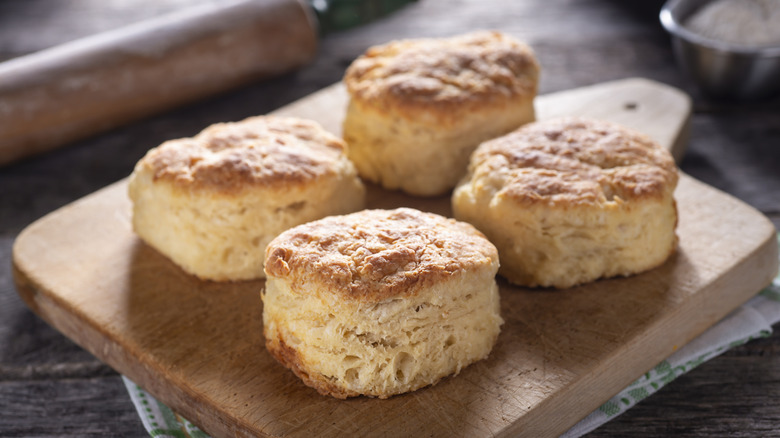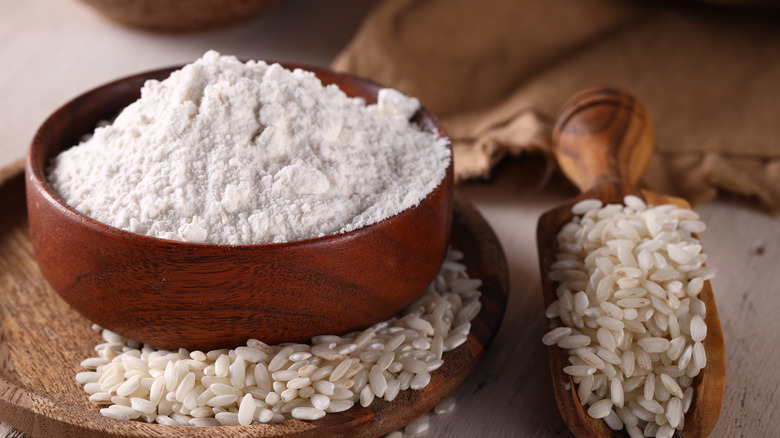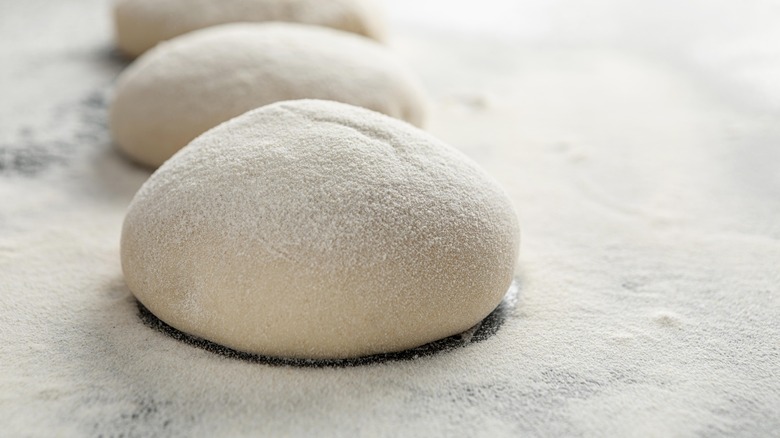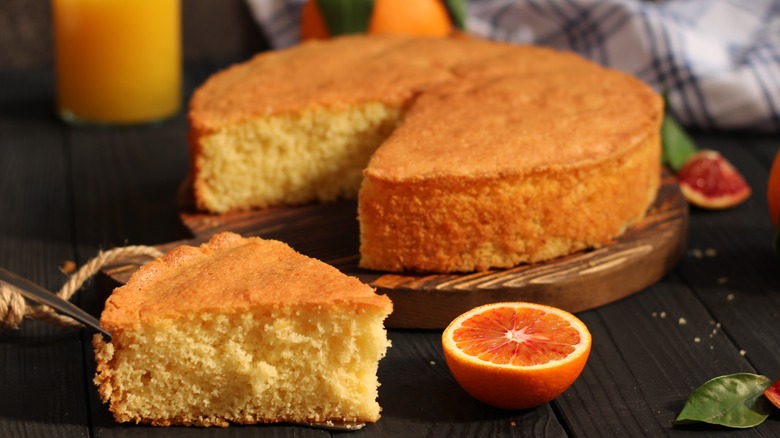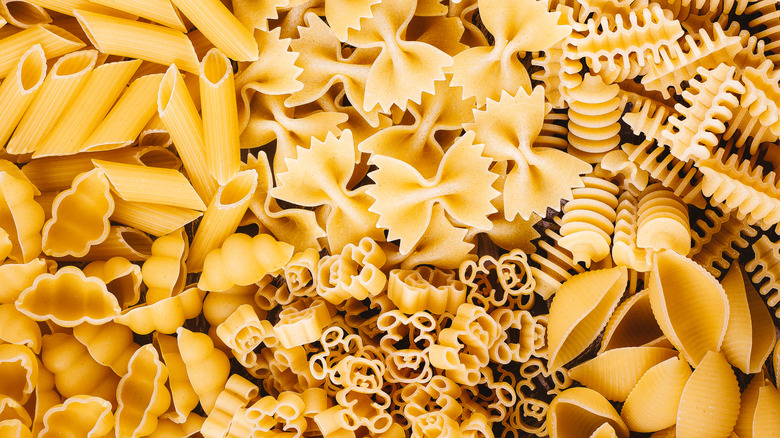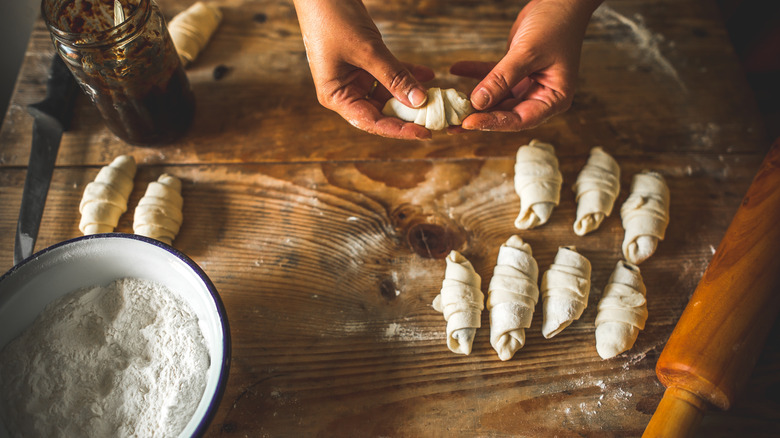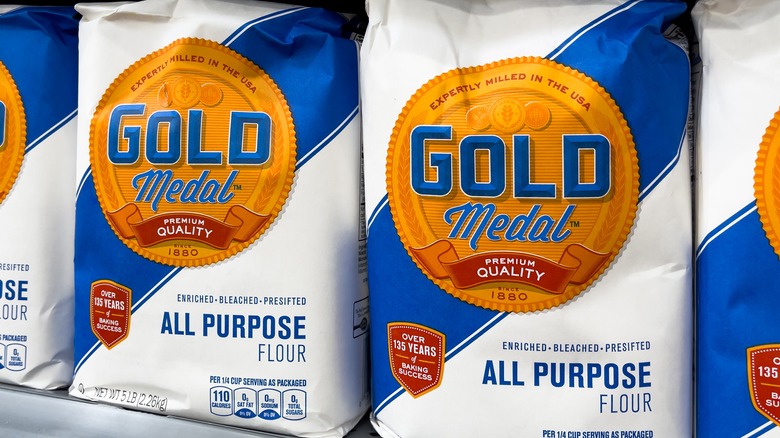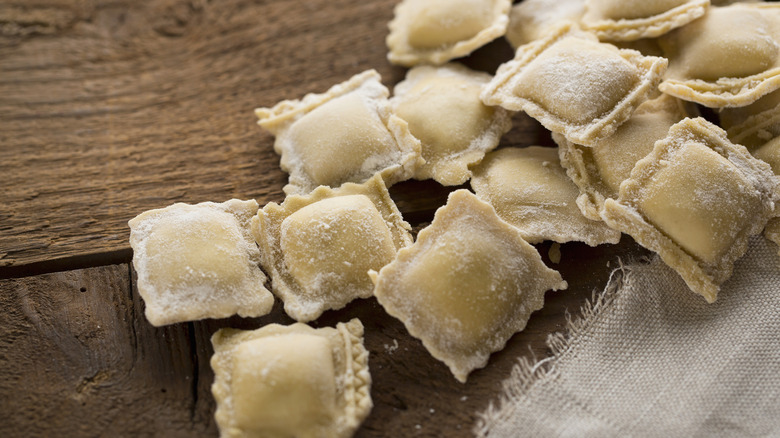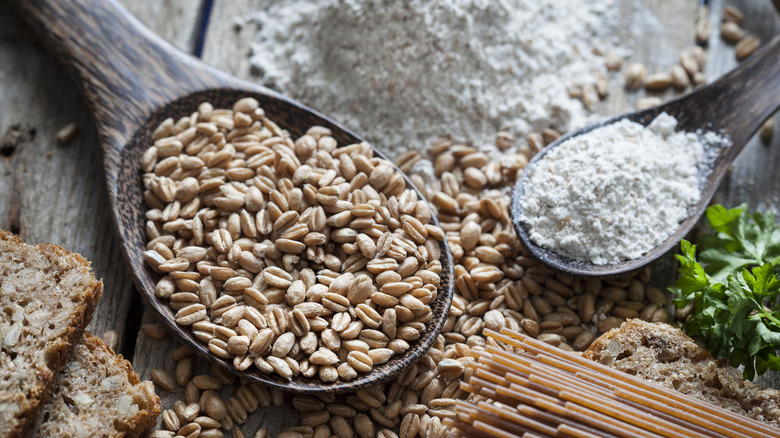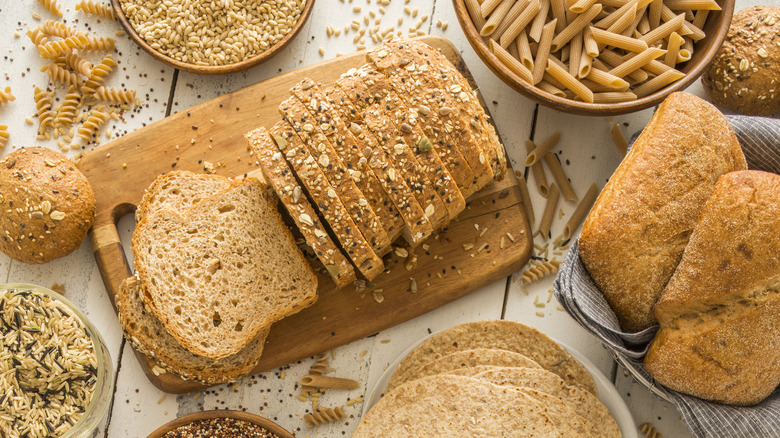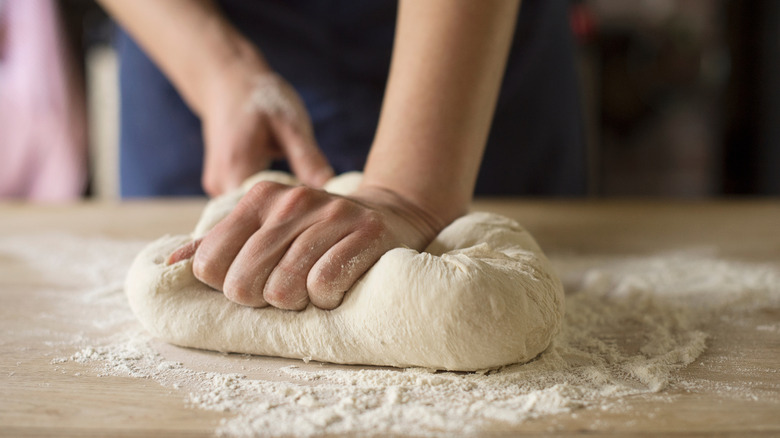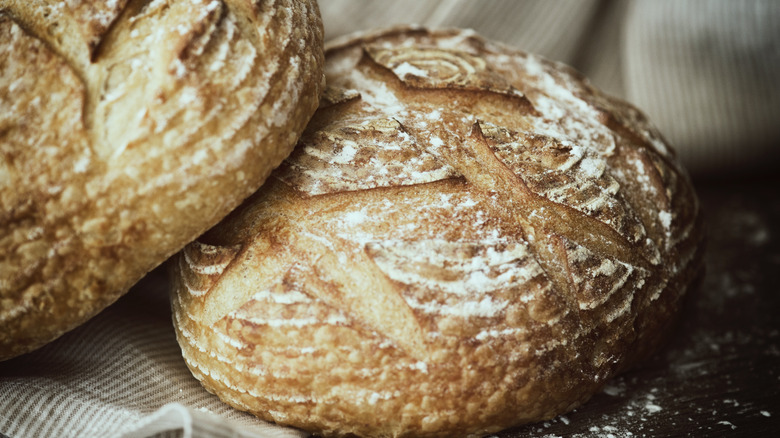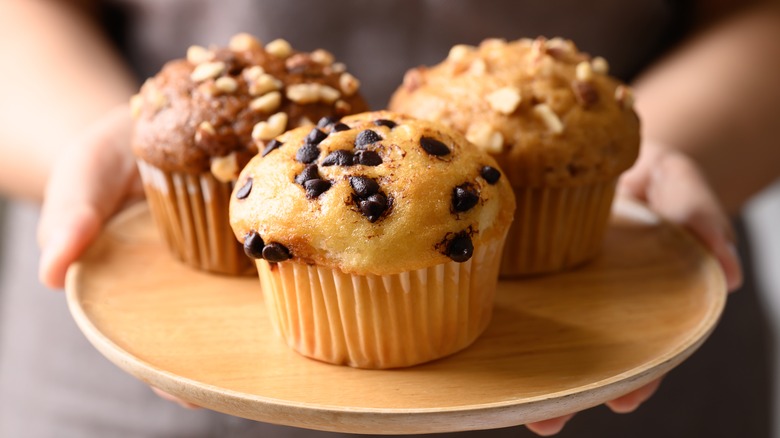The Best And Worst Flours To Use When Making Homemade Biscuits, According To Experts
We may receive a commission on purchases made from links.
Fluffy, buttery, and lightly crispy on the outside, the perfect biscuit is a marvel of the culinary arts. They may not be as eye-catching as mille-feuille or as packed with flavor as a Key lime pie, but biscuits are exquisite when executed correctly. Considering that you only need three ingredients for biscuits and 20 minutes to make them, you'd think baking them would be even simpler than producing a loaf of zucchini bread or batch of blueberry muffins. But this delicious Southern staple isn't just any quick bread, and it has its own set of requirements.
"Baking biscuits is unique due to its focus on achieving a tender texture, which is accomplished through techniques like cutting in fat to create layers," explained Cole Jeanes, pastry chef and owner of the Memphis restaurant Kinfolk. "Unlike yeast breads that require proofing and longer rising times, biscuits rely on baking powder or baking soda for a quick rise, allowing for faster preparation with minimal ingredients — typically just flour, fat, liquid, and a leavening agent. The mixing technique is crucial; it requires careful mixing to avoid developing too much gluten, which can make the biscuits tough."
Most important of all, however, is the ingredients. Since biscuits require so few of them, the quality of each can make or break the recipe. This is especially true of flour, which forms the bulk of the final product. Mashed spoke with three biscuit experts to learn which types of flour they use, and which they avoid.
Gluten-free flour
Gluten-free flour is a godsend for those who are gluten-intolerant or gluten-sensitive but love all things bread-related. When used in certain recipes, it can even create identical results to gluten-based flour. But when it comes to biscuits, gluten-free flour is one of the worst options. "Biscuits rely on the structure and elasticity of gluten to create that signature light, flaky texture," said culinary scientist and food writer Jessica Gavin. "Gluten-free flours have a lower protein content (below 8%) than wheat flour's 10 to 13%, which means they can't develop the same structure. This results in denser, drier, and more crumbly biscuits that lack [the] classic versions' lift and tender crumb."
There are many variations of gluten-free flour, and some are better than others at replicating wheat flour. For example, almond flour is the key to achieving moist cakes and quick breads. However, as Gavin noted, no type of gluten-free flour is able to provide a comparable result when used in biscuit recipes. "Binders like xanthan gum help but only partially replicate the airy rise or delicate texture," she said. "While gluten-free flour works well for dietary needs, it's not ideal for achieving soft, tender biscuits."
Bread flour
Bread flour is one of those practical ingredients that does exactly what it tells you on the packaging. As Biscuitville's corporate executive chef and chief biscuit expert Steve Mueller told us, "Bread flour has a very high protein content, between 11 and 13%, and is made from hard winter wheat. This is ideal for making bread, because the high protein content is going to become glutinous when you add [your] liquid and start mixing. This gluten is going to [cause] all the dough to stretch and stand up to the kneading and the rising that [is] required to give you the chewy texture of great bread or a pizza dough."
Its credentials for producing great bread are unassailable, but as Mueller noted, the things we look for in a perfect pizza crust are exactly the opposite of what we're looking for in a perfect biscuit. You want biscuits to be fluffy and tender, not chewy. For all its merits, bread flour will increase the likelihood of rubbery biscuits, especially if you work the dough a little too much and increase the gluten formation.
That said, some chefs are happy to use bread flour for biscuits. It creates a sturdy texture and may result in more body, but you have to be much more mindful of not overworking the dough. In short, if bread flour is your only option, you could do much worse, but it isn't the go-to flour of any of the biscuit experts we spoke to.
Cake flour
Cake and biscuits have many similarities. They are both quick breads, meaning that they require baking powder or baking soda to rise, and they benefit from a more tender texture than yeast breads, which are usually more springy and elastic. Biscuit flour is not a standardized product, so if you were buying a type of flour geared toward a specific type of recipe, it stands to reason that cake flour would be the closest match to what biscuits would need. However, as Jessica Gavin explained, it is actually one of the worst options.
"Cake flour, with a lower protein content (6 to 8%), is better suited for delicate cakes and can make biscuits too crumbly due to its reduced level of gluten formation," she said. Biscuits fall into a middle ground of baking. They need some gluten in order to stand alone without a mold and have a slightly springy texture, but too much gluten and they'll be rubbery rather than light. Like bread flour, cake flour will throw off that perfect texture, but for the opposite reasons, and if you had to choose between the two, bread flour is probably better. Since biscuits usually need to hold up to being sliced across the middle and spread with butter, clotted cream, and jam, it's best to err on the side of sturdiness rather than tenderness.
Semolina flour
If you've ever been to a grocery store with an extensive baking section, your gaze will likely have passed over a bag of semolina flour, even if you never stopped to read the packaging. As Jessica Gavin told us, semolina flour is made from durum wheat and has a coarse texture, golden color, and nutty flavor. In the Middle East, semolina flour is common, but in other parts of the world, it is usually relegated to the specialty flour section with products like almond flour and spelt flour. Outside the Middle East, its main claim to fame is as the preferred flour for making pasta. It's even called pasta wheat in Italy. If you've ever wondered how tiny pieces of pasta can maintain such intricate shapes, semolina is the answer. With a high protein content of 13% or more, it provides the structure and chewy texture that we associate with pasta. It is also the ingredient that will give your pizza crust that desired crunch.
It probably won't surprise you to find out that, while perfect for macaroni, semolina flour is not the best choice for biscuits. As Gavin explained, its coarseness and high gluten content are exactly the opposite of what you need to create a light, tender crumb. "You can substitute semolina for 25% of the all-purpose flour in your biscuit recipe to add a rich flavor and a bit of texture," she said, "[B]ut using too much will result in a denser, less soft biscuit."
Pastry flour
Pastry flour is the one-stop-shop for all things pastry. Think of flaky croissants and tender, sugary tart shells, and you'll get the idea of what this miraculous ingredient can achieve. With between 7.5 and 9.5% protein content, it falls on the mid-to-low end of the protein spectrum, but it is much more of an all-rounder than you might expect. For Jessica Gavin, pastry flour is the preferred flour for making biscuits. Its protein content is ideal for the Southern staple, she explained, because it "provides the right balance of tenderness and structure, creating a light, flaky texture."
She highlighted the differences of pastry flour versus cake flour, explaining that the slightly lower protein content of the latter just isn't enough to provide strength and sturdiness. On the other end of the spectrum are the higher protein flours like bread flour and semolina flour, both of which take the sturdiness a little too far and can yield stiff, dense results. "Pastry flour is the superior choice for the best biscuits ... because it creates soft yet well-structured results," Gavin said.
All-purpose flour
All-purpose flour is the Renaissance man of flours — it can do a little bit of everything. It might not excel in every recipe, but whether you're baking muffins, a pie, a loaf of challah, or chewy chocolate chip cookies, it will yield decent results. It usually has a protein content of around 11 or 12%, putting it right in the center of the protein spectrum. If you only have one bag of flour in your pantry and like to make a wide variety of recipes, all-purpose flour is, as its name suggests, the best option. When it comes to getting the most out of specific recipes, however, it is rarely the perfect option. There are many biscuit recipes that call for all-purpose flour, but for the biscuit experts we spoke with, it is nothing more than a distant second or third option on the list.
"If for some reason I can't find a self-rising flour that is made from soft red winter wheat," Steve Mueller told us, "I would look for one made with soft white winter wheat. In a pinch, you could use [all-purpose flour] and add the leavening agent [yourself]." Ultimately, if you use good quality butter and take care not to overmix the dough, you can produce great biscuits with all-purpose flour, but it isn't the preferred option for any of the experts we spoke to.
00 flour
There is probably a significant number of bakers who have never heard of 00 flour. There are plenty of other options to choose from, many of which have much more descriptive names that make the choice easy. If you're making pie crust, you go for pastry flour. If you're making pizza crust, you go for bread flour. Whereas, 00 flour is neither as common as these options nor as obviously applicable. But as Jessica Gavin explained, you might want to add it to your repertoire. "00 flour, doppio zero, is a finely ground Italian flour for making pasta and pizza dough," she explained. "The '00' refers to its ultra-fine texture, not the protein or gluten content. Typically made from soft or durum wheat, this flour is prized for creating tender and light doughs."
Although it is an Italian flour made from durum that is used for making pasta, 00 flour should not be confused with semolina flour, which is coarser and yields much stiffer results. While semolina flour is not recommended for biscuits, Gavin said that 00 flour is an excellent, if unconventional, option. "Compared to all-purpose flour, [which is] a blend of hard and soft wheat, 00 flour's fine grind and balanced protein make it an excellent choice for biscuits," she said. "Its lower gluten development ensures the biscuits won't turn out tough, and its fine grind helps with hydration, requiring less water. The result is soft, airy, and flaky biscuits like those made with Southern soft wheat."
Spelt flour
There was a period in the late 2010s when it seemed like spelt flour was everywhere. From the snack aisle to the dessert menu of upscale restaurants, the ancient grain was the ingredient of the moment. For those wondering about the health benefits of spelt flour, the answer is clear. It wasn't just a fad. As a whole grain, spelt flour is more nutritious than plain white flour. It's full of fiber and protein, and is higher in the minerals copper, zinc, and manganese than regular refined wheat flour. For those who are sensitive to gluten but are not intolerant, spelt can be a good alternative. It contains gluten, which makes it an easy substitute for standard wheat flour, but its protein does not form gluten as easily as regular flour, making it easier to digest.
If you're making biscuits, however, spelt flour is not the best option due to its high protein and fiber content, which can make the texture heavy. It also has a distinctive nutty flavor which could either be a selling point or a drawback depending on your tastes. However, if you want to use a whole grain flour, spelt is much better than whole wheat due to its weaker gluten structure. Instead of being chewy and dense, the biscuits will be tender and only slightly heavier than desired.
Whole wheat flour
Whole wheat flour is the go-to option when you want to make a baked recipe a little bit healthier. Unlike white flour — which is made by removing the exterior shell of the wheat kernel (the bran) and the inner part of the seed (the germ) and grinding the soft endosperm — whole wheat flour contains the bran, germ, and endosperm. Because it contains all elements of the grain, whole wheat flour is higher in fiber, protein, calcium, iron, and B vitamins.
If you're looking for a nutritious and readily available alternative to white flour, whole wheat flour is usually the perfect option. But as Cole Jeanes told us, it should be far down on your list when it comes to making biscuits. "I wouldn't recommend using whole wheat flour for making biscuits if you're looking for a light and flaky texture," he said. "Whole wheat flour has a higher protein content and absorbs more liquid, which can make biscuits denser and less tender compared to using all-purpose flour or cake flour." If you want the nutritional advantages of whole grain flour, spelt flour is better suited to biscuits.
Strong flour
Strong flour doesn't sound particularly scientific. It doesn't tell you anything about whether it contains whole grains or what type of recipe it's best suited to. It isn't even clear what makes it strong. Ideally, brands would put a little more description on the packaging to explain exactly what the term means, but for those who aren't clear, strong flour is just another word for bread flour, and is more commonly found in the U.K. than the U.S. If you're looking for bread flour but the store only has strong flour, you will notice no difference in the results, though they will vary between brands.
The strength of the flour is due to its protein content. As a general rule, it contains at least 12.5% protein, which is higher than all-purpose flour. This leads to more gluten formation, which is ideal for bread bakers who need plenty of gluten for the loaf to rise, but it's a distinct disadvantage for foods that need a tender texture, such as biscuits. The results will still taste delicious, but they won't be as light and flaky as they would with self-raising flour, all-purpose flour, or pastry flour.
White whole wheat flour
White whole wheat flour sounds like a contradiction. We usually refer to refined grains as white flour, because removing the bran and the germ leaves the resulting product white, but some types of wheat are white even when the grain is left intact. White whole wheat flour is made from hard white spring or winter wheat. It is white regardless of whether you remove the bran and germ or not. Regular whole wheat flour, on the other hand, is made with hard red spring or winter wheat, which has a reddish brown color when left intact.
White whole wheat flour and regular whole wheat flour have the same nutritional content, but whole wheat flour has a slightly nuttier flavor and a darker color. If you want to make a loaf of bread with a lighter color and milder taste, white whole wheat flour is perfect. However, if you're making biscuits, it will yield the same dense, stiff texture as whole wheat flour. They may be the same color as biscuits made with all-purpose or pastry flour, but that's where the similarities end.
Self-rising flour
When we asked the experts which type of flour they use for biscuits, self-rising flour was the clear favorite. "We use White Lily [Self-Rising], Unbleached," Cole Jeanes told us. "White Lily is made from soft red winter wheat, which has a lower protein content than all-purpose flour. This results in a more tender biscuit texture. The self-rising aspect means it already has baking powder and salt mixed in, simplifying the baking process and ensuring a reliable rise. Being unbleached, it retains more of its natural flavor and color, contributing to a richer taste. It has excellent moisture absorption properties, helping to create a soft biscuit without being dry."
Steve Mueller had a similar answer. "The best type of flour for making biscuits is going to be a self-rising flour that is made with soft red winter wheat, like we use at Biscuitville," he said. "When you are making biscuits, you want the inside to be light and flakey, with a little bit of texture on the outside. Soft winter wheat has a protein content between 6 and 9%. In contrast, [all-purpose] flour is usually between 9 and 11%, and bread flour is between 11 and 13%. The protein content of the flour is directly related to how glutinous the final product will be." If you can find a type of self-rising flour made with 100% soft red winter wheat, you'll be well on your way to baking the perfect biscuit before you measure a single ingredient.
